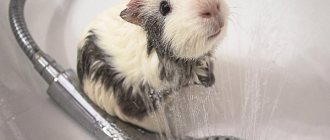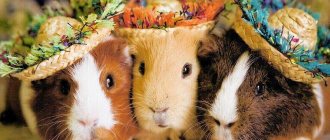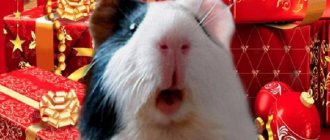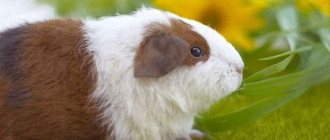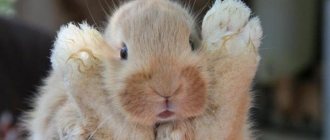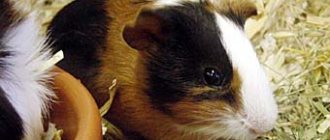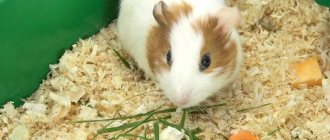We learn how to cut a guinea pig's hair and trim its claws. What you need to know about caring for your pet's long hair. When it is necessary to cut the wool. How to properly cut a haircut and what tool to use. Do you need to trim your guinea pig's claws and how to do it correctly.
Guinea pigs need the care and attention of their owners, which is manifested not only in arranging the territory for housing and food, but also in bathing, caring for fur and claws, cleaning ears and other actions.
Some breeds have quite long fur that they cannot handle on their own, so owners must help the pet care for it. Next, we will look in detail at how to properly care for the fur, whether it is possible to trim your pet, and how to carry out the procedure correctly.
Medical examination and basic care
Regular preventive examinations will help avoid many rodent health problems. A healthy guinea pig is active and eats well.
First of all, when examining, you should pay attention to the coat - it should be shiny and without bald spots. There should be no wounds or ulcers on the skin. A healthy rodent's breathing is smooth, without wheezing, its eyes are bright, without any signs of infection.
Caring for a domestic pig is not particularly difficult. Many people can easily cope with this. These recommendations must be followed:
- feeding at a strictly defined time - twice a day;
- cleaning the feeder and changing the water in the drinking bowl - once a day;
- change of litter - once every four days;
- general cleaning of the cage - once every seven days;
- preventive examination - once every three days;
- combing the coat - once every two days;
- claw trimming - once every six months.
All of the above procedures take about two hours a week.
In order for your pig to develop active and healthy, it needs daily walks. You can let it run around the room, but you should be careful not to accidentally press the rodent against the door or step on it. If you want to catch a furry animal, do it quickly and confidently. Place one hand under the pig's butt and grab the back with the other. Pregnant animals and newborn rodents should not be handled.
How to properly trim a guinea pig's claws
A good time for manicure procedures is immediately after your pet wakes up. After sleep, the animals remain inactive for some time.
The pet should be carefully removed from the cage and calmed down with stroking movements. To reduce the risk of injury during the procedure, the pig is placed on your lap. It is better to place your pet on its back with its head away from you. The index finger and thumb of one hand hold the paw, and the remaining fingers fix the animal’s head. With the second hand you calm the pet, you can give the animal a treat. This position will help control the rodent's movements. If the pig is calm, you can take the tweezers and start trimming the nails.
Pigs have 14 toes, 4 on the two front legs and 3 on the hind legs. Only a small part of the nail is cut off so that about 1–2 mm remains before the nerve ending and the vessel. When using tweezers, it is better not to cut off the entire nail, but to trim its edges. Thus, the likelihood of damaging the nerve and vessel is reduced, and at the same time more of the keratinized part is removed. You need to cut the guinea pig's claws at an angle so that later it can place its paw straight on the surface.
The procedure must be carried out in a illuminated place, preferably directly under a light source. If the pig’s claws are transparent, then there will be no problems determining where to use the nail cutter, but if the pet’s claws are black, then it is better to use a nail file. But even in this case, you can determine where to cut. The non-living part of the nail is thinner than the living part, and there is a transition visible on the underside of the nail that can be trimmed.
If it was not possible to trim your guinea pig's claws without bleeding, then you need to use a hemostatic agent. After the bleeding has stopped, excess powder should be removed to avoid it entering the animal's digestive tract. Bleeding in itself is not dangerous, although it is quite painful.
If after finishing the haircut there are uneven areas on the nails, they are treated with a nail file.
The claws on the hind legs are slightly longer than on the front legs.
It will be easier to trim your nails using an electric sharpener. Its price is higher than the cost of a nail clipper, but the risk of injuring the animal is practically eliminated.
It’s easier to carry out the procedure together, but when the pig gets used to it, one person can do it.
After trimming the claws, you need to change the bedding in the cage so that dirt does not get into possible wounds on the paws and infection does not occur.
Brushing the pig
Guinea pigs look after themselves independently. They comb their fur using their teeth and claws. But it won’t be superfluous for the owner to sometimes comb the pet himself.
For long-haired individuals, brushing is only useful. They help prevent the appearance of tangles and massage the skin perfectly. If a piece of matted fur is found during combing, it is better to cut it out immediately with scissors. Guinea pigs have their own special combs.
Before the onset of summer, some varieties of pigs are trimmed, for example, the Angora guinea pig. Pregnant females are also trimmed to make it easier for the young to gain access to their mother’s nipples.
Of all the breeds, the Peruvian pig needs brushing the most. The length of its coat reaches 20 cm. This breed needs to be brushed three times a week to prevent the coat from becoming tangled.
In addition, with proper nutrition and daily brushing, the pig's coat becomes silky and shiny. The rodent's hair will be strong and thick if you include flaxseed and sunflower seeds in the diet.
How to cut your hair correctly
In the event that an animal needs to be trimmed and prepared for an exhibition, one cannot do without the services of a professional who uses special scissors and other equipment for grooming.
But if this is not preparation for an exhibition, then you can use a regular machine, with which the required length is removed. When a young female becomes a mother, the hair around her nipples is trimmed to facilitate the process of feeding her cubs.
If tangles have formed, it is recommended to try to comb them out using brushes and a comb. But if the tangle is very matted, you should not do this, since you will not be able to untangle it, and the manipulations carried out will cause pain to the pet, it is better to trim them carefully, for this I use nail scissors.
You should turn to professionals, namely groomers, if you need a haircut for an exhibition, or if your pet really doesn’t like getting a haircut, behaves restlessly and does not allow the procedure to be carried out.
If you decide to cut your hair yourself, you must adhere to the following rules:
- The procedure should be carried out no more than once per quarter.
- You will need to remove tangles, as well as strands that look unkempt.
- Carry out a haircut when it gets hot, closer to summer.
To trim your rodent, you can use scissors and clippers.
Bathing a rodent
It is worth bathing animals in case of severe contamination. For example, with diarrhea, when the wool is dirty. If you decide to give the animal a bath, proceed according to the following algorithm:
- Fill a deep bowl with warm water, about 4 cm;
- Place the pig in a bowl of water;
- Wash the rodent gently with baby wash or soap, avoiding getting the ears and head wet;
- After bathing, dry your pig well with a towel;
- At room temperature below 18° C, it is better to dry the wool with a hairdryer.
Rodents with long hair are always dried with a hair dryer. The furry pig is very susceptible to drafts and colds. If not properly cared for, the animal may become ill.
Preparation for the procedure
Before starting the procedure, you need to prepare your tools. For cutting you will need special tweezers. They are sold in pet stores and are called rodent nail clippers. A nail clipper for rodents can be replaced with children's tweezers or a nail clipper for cats. For very small piglets, regular nail scissors are also suitable, since babies have soft nails. In cases where it is impossible to accurately determine the safe place to use a nail clipper, it is better to use a nail file. An ordinary nail file that people use or a special device - an electric sharpener - will do. It is sold in pet stores. The nail plate of animals contains a nerve ending and a vessel. If you cut a nail and touch a vessel or nerve, bleeding will occur. In this case, you will need powder to stop bleeding. This may be a special product that is sold in a pharmacy. Chlorhexidine, hydrogen peroxide, brilliant green and a weak solution of potassium permanganate are also suitable for treating the wound. In case of treatment with liquid products, you will need cotton pads. You will also need a towel for a manicure. The pet is wrapped in it to calm it and prevent bites.
Drinking regime and nutrition
It is more convenient to feed a guinea pig with ready-made concentrated food, at the rate of 20 g per kilogram of animal weight. If you give crackers, white bread or crispbread as a treat, you should know that such food is part of the finished food. Therefore, it must be given in accordance with the permissible volume.
It is worth adding 50 grams of succulent feed and fresh hay to the finished concentrated mixture. This type of feeding allows you to maintain the pig’s health at a high level, since all food has a balanced composition and is rich in vitamins and minerals.
Water is of great importance for rodents. Therefore, it is worth washing the sippy cup every day and pouring fresh, clean water. As vitamins, you can add ascorbic acid to the sippy cup at the rate of 30 ml per 100 ml of liquid. Vitamin C solution can be obtained from a veterinary clinic or pharmacy.
Preparing tools
The most sensitive part of a guinea pig is its claws. The claw contains pulp with blood. If you trim the nail incorrectly, your pet will bleed, which will lead to serious consequences, including numbness of the limb. How to trim a guinea pig's claws without harming the pet? Thorough preparation is the first step to a successful procedure. Before cutting an animal, you need to purchase the appropriate tools:
- Wire cutters. You can cut it for children or buy a tool in the store.
- Powder to stop bleeding. Beginners who have recently acquired a rodent, when cutting, touch a blood vessel or deform their nails. The powder allows you to quickly stop bleeding. Corn starch is commonly used.
- Terry towel. An animal wrapped in soft fabric will stop being nervous.
Dental care
If a four-legged pet does not receive enough solid food, then its teeth begin to grow. Most rodents, including pigs, grow their upper and lower front incisor teeth, even if they regularly grind them down on hard objects. Excessively long front teeth can damage the tongue and gums. In addition, eating food becomes significantly more difficult.
In advanced cases, guinea pigs refuse to eat and ultimately die if they do not contact a veterinary clinic in time. Therefore, as a preventive measure, it is necessary to allow the pig to gnaw on special hard things, for example, branches of fruit trees.
If the “client” is worried...
Not all animals experience the thrill of having their nails trimmed. If your pet strongly protests against the manipulations being carried out on it, you can try to calm it down in various ways. So, swaddle it in a towel (remember that?), take it out one paw at a time and cut it one by one.
How does an allergy to guinea pigs manifest?
It has been noticed that some guinea pigs are terribly afraid of water, and even the sound of a flowing stream has a hypnotic effect on them . Therefore, it is recommended to perform the entire operation to remove overgrown claws in the bathroom, turning on the tap.
There is also a more benevolent way - to distract the animal during the procedure with its favorite food, a piece of pumpkin or celery, for example.
Why trim nails?
If you have a guinea pig in your home, then you should trim it regularly.
It is necessary to constantly monitor the condition of your nails
There are several reasons for this:
- creating comfortable living conditions; prevention of damage to furniture and other things; animal safety.
If your pet's claws are not cut off in time, as they grow back, they curl and pierce their paws. A wound forms on the damaged area, which does not heal due to the nail growing in it. Injury to other parts of the body is also possible. If a pig wants to scratch itself, it will inflict many wounds on itself. In addition, dirt accumulates under the claws, which causes the wound to become infected. As a result, skin diseases or infection of the entire body are possible.
Long claws on the paws prevent the pig from walking normally. Because of this, she will move less, which will lead to obesity. If your pet roams freely around the house, it can damage furniture and wallpaper with its claws. Therefore, haircuts should be carried out at least once a month.
Origin story
Many people are interested in the question: why is the pig called “guinea pig”? Paradoxically, the animal is in no way related to ordinary pigs and has never lived in the sea. There is a theory that the pig was originally called “overseas”, but gradually the name changed a little. It first came to Europe from North Africa, although South America is considered the homeland of this wonderful animal. The indigenous people of the American continent not only ate guinea pigs, but also sacrificed them to the gods. The Indians destroyed black individuals, as they considered them a harbinger of trouble. Today, the black guinea pig is considered the most fashionable and expensive species.
Description of appearance
This animal is characterized by the following external signs:
- The guinea pig is larger than a hamster and a domestic rat. The weight of an adult male reaches 2 kg. The female guinea pig is slightly smaller in size.
- The body of rodents is cylindrical in shape, smoothly turning into a rather large head.
- Your pet's teeth can grow throughout his life, so constant grinding is essential.
- Depending on the breed, a guinea pig can be either long-haired or short-haired. They also differ in the variety of fur coat colors.
Animals live up to 15 years, although most of them barely reach 10. Depending on the care, the health of the pet will depend, as well as its duration of existence.
Procedure
Let's look at the step-by-step process of how to trim a guinea pig's claws. The step-by-step process for treating rodent claws is as follows:
- Take your guinea pig and pull out one of its legs (take them one at a time).
- Secure the claw between your thumb and index finger.
- Take the nail clipper in your free hand and place it in front of the nail.
- Look carefully at where the blood vessel ends (if you can't see it, you can shine a flashlight on the paw), and trim the claw just above it.
- Once the grooming is complete, return your pet to the crate.
It is also recommended to replace the bedding so that dirt from soiled sawdust does not get under the rodent's trimmed claws.
Useful tips
In conclusion, we will give some useful tips that will help you better understand how to trim your guinea pig’s nails:
- If your pet pulls its paw out, do not try to stop it. Wait a few minutes for the animal to calm down, and then try again.
- If the vessel inside the nail is not visible even with backlighting, trim the plate a little at a time or use a nail file so as not to injure your finger.
- For bleeding caused by accidental damage to a vessel, use starch or hemostatic powder. After completing the procedure, the remaining substance must be removed so that the pig does not eat it.
- If your pet continues to try to escape, you can swaddle it to avoid being bitten and pull out its paws one at a time.
- Distraction techniques work well with animals. Try, for example, to switch your pet’s attention to a treat or the sound of flowing water (at the sound of water, the guinea pig simply freezes).
- An extreme measure applied to particularly aggressive animals is the use of a muzzle for small breed dogs or cats.
Now you know the answer to the question of whether guinea pigs have their nails trimmed. But if you still find this process too difficult, contact your veterinarian. He will give you practical recommendations or carry out the procedure himself efficiently and quickly.
And in one of our previous articles we talked about how to bathe a guinea pig and whether it is necessary to do this, be sure to read it, this article will certainly be of interest to you!
Did you like the article? Share with friends: [supsystic-social-sharing id=”1"]
- Related Posts
- Caring for a guinea pig at home
- Skinny Guinea Pig
- Can guinea pigs have grass?
« Previous entry
Microclimate
Overheating and hypothermia are the same and are harmful to animals. It is worth noting that it is more difficult for a rodent to tolerate heat, but if the temperature in the room is too low, the pig may get sick. Therefore, you should not keep the cage near the front door or open window. The optimal temperature for keeping a pet is considered to be 16-20 degrees.
The air humidity in the room where the animal is kept should be in the range of 50-60%. Too dry air can cause cracks in the animal's skin, and too humid air can cause a fungal infection.
Kewis are diurnal, so lighting is important for them. But rodents should be protected from exposure to direct UV rays of the sun.
As you can see, keeping a guinea pig is not difficult even for beginners. A guinea pig, the care and maintenance of which at home will not cause you much trouble, will delight all members of your family.
